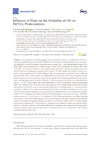Please use this identifier to cite or link to this item:
https://accedacris.ulpgc.es/jspui/handle/10553/76438
| Title: | Influence of water on the oxidation of no on pd/tio2 photocatalysts | Authors: | Hernández Rodríguez, M. J. Melián, E. Pulido Araña, J. Navío, J. A. González-Díaz, O. M. Santiago, Dunia E. Doña Rodríguez, J. M. |
UNESCO Clasification: | 221001 Catálisis 2307 Química física |
Keywords: | FTIR NOX PD Photocatalysis TiO2, et al |
Issue Date: | 2020 | Project: | Hormigones Fotocatalíticos Eliminacion Fotocatalitica de Mezclas de Nox y Covs en Emisiones Gaseosas Con Ti02 y Oxidos Mixtos. |
Journal: | Nanomaterials | Abstract: | Two techniques were employed to incorporate Pd nanoparticles on the P25 surface: photodeposition (series Pd-P) and impregnation (series Pd-I). Both series were characterized in depth using a variety of instrumental techniques: BET, DRS, XRD, XPS, TEM, FTIR and FESEM. The modified series exhibited a significant change in pore size distribution, but no differences compared to the original P25 with respect to crystalline phase ratio or particle size were observed. The Pd0 oxidation state was predominant in the Pd-P series, while the presence of the Pd2+ oxidation state was additionally observed in the Pd-I series. The photoactivity tests were performed in a continuous photoreactor with the photocatalysts deposited, by dip-coating, on borosilicate glass plates. A total of 500 ppb of NO was used as input flow at a volumetric flow rate of 1.2 L·min−1, and different relative humidities from 0 to 65% were tested. The results obtained show that under UV-vis or Vis radiation, the presence of Pd nanoparticles favors NO removal independently of the Pd incorporation method employed and independently of the tested relative humidity conditions. This improvement seems to be related to the different interaction of the water with the surface of the photocatalysts in the presence or absence of Pd. It was found in the catalyst without Pd that disproportionation of NO2 is favored through its reaction with water, with faster surface saturation. In contrast, in the catalysts with Pd, disproportionation took place through nitro-chelates and adsorbed NO2 formed from the photocatalytic oxidation of the NO. This different mechanism explains the greater efficiency in NOx removal in the catalysts with Pd. Comparing the two series of catalysts with Pd, Pd-P and Pd-I, greater activity of the Pd-P series was observed under both UV-vis and Vis radiation. It was shown that the Pd0 oxidation state is responsible for this greater activity as the Pd-I series improves its activity in successive cycles due to a reduction in Pd2+ species during the photoactivity tests. | URI: | https://accedacris.ulpgc.es/handle/10553/76438 | ISSN: | 2079-4991 | DOI: | 10.3390/nano10122354 | Source: | Nanomaterials [EISSN 2079-4991], v. 10 (12), 2354, 16 p. (Diciembre 2020) |
| Appears in Collections: | Artículos |
SCOPUSTM
Citations
9
checked on Jun 8, 2025
WEB OF SCIENCETM
Citations
6
checked on Jun 8, 2025
Page view(s)
152
checked on Jan 23, 2024
Download(s)
71
checked on Jan 23, 2024
Google ScholarTM
Check
Altmetric
Share
Export metadata
Items in accedaCRIS are protected by copyright, with all rights reserved, unless otherwise indicated.
